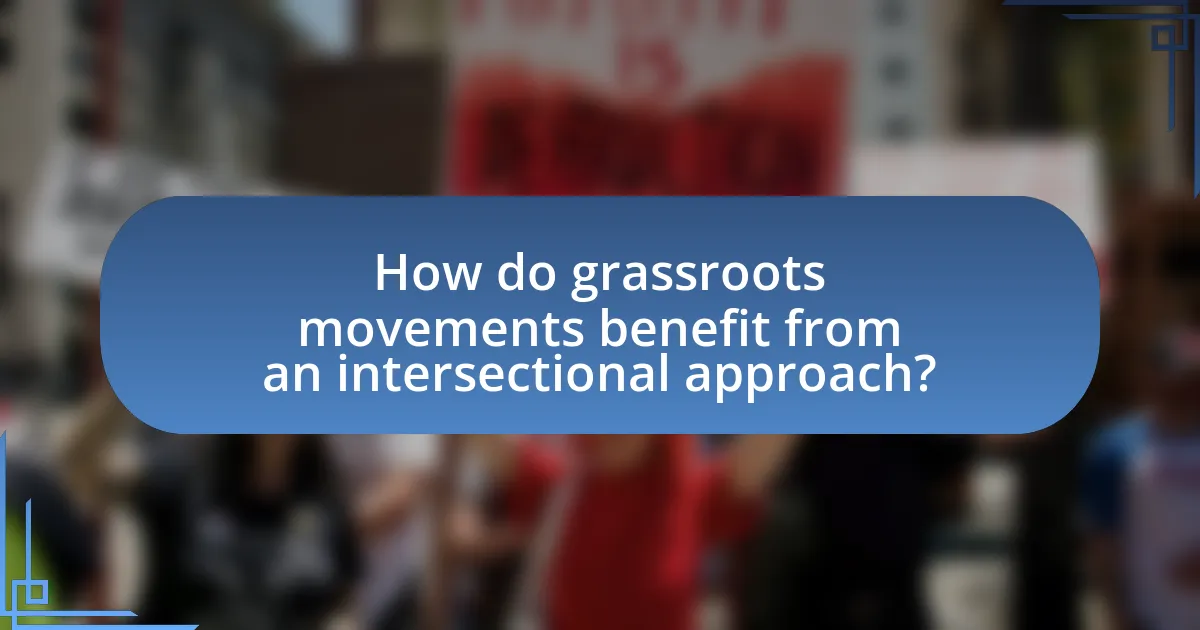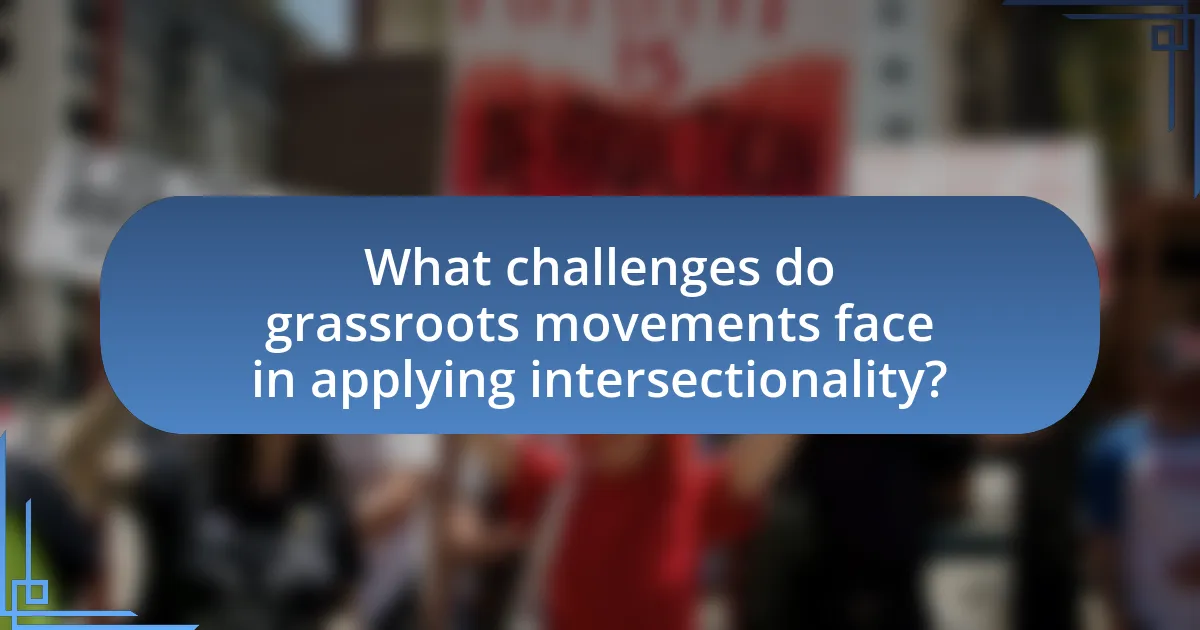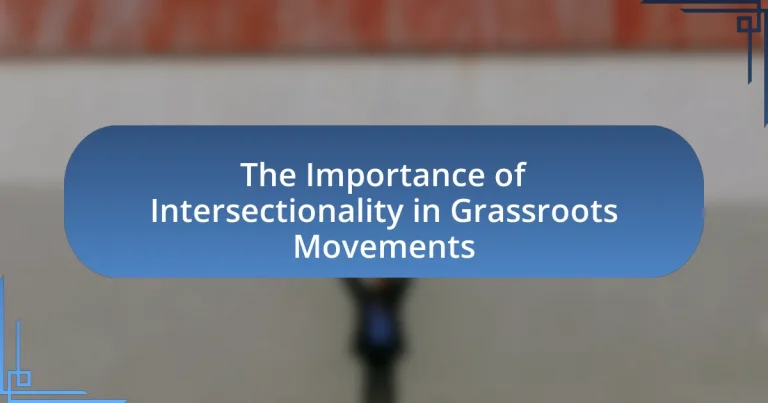The article focuses on the significance of intersectionality in grassroots movements, emphasizing how various social identities—such as race, gender, class, and sexuality—intersect to shape unique experiences of oppression and privilege. It outlines the influence of intersectionality on grassroots activism, highlighting its role in fostering inclusivity and effective advocacy strategies that address the diverse needs of marginalized communities. Key principles of intersectionality are discussed, along with its impact on community engagement, coalition-building, and addressing systemic inequalities. The article also addresses challenges faced by grassroots movements in applying intersectionality and offers practical steps for organizations to embrace this framework, ultimately enhancing their effectiveness in driving social change.

What is Intersectionality in Grassroots Movements?
Intersectionality in grassroots movements refers to the framework that recognizes how various social identities—such as race, gender, class, and sexuality—intersect to create unique experiences of oppression and privilege. This concept is crucial for grassroots movements as it emphasizes the need for inclusive strategies that address the diverse needs of marginalized groups. For instance, Kimberlé Crenshaw, who coined the term “intersectionality,” highlighted how Black women face discrimination that is not solely based on race or gender but on the combination of both, which traditional movements often overlook. By applying an intersectional lens, grassroots movements can foster solidarity and create more effective advocacy that resonates with a broader spectrum of individuals, ultimately leading to more equitable social change.
How does intersectionality influence grassroots activism?
Intersectionality influences grassroots activism by highlighting the interconnected nature of social categorizations such as race, gender, and class, which can create overlapping systems of discrimination or disadvantage. This framework allows activists to understand and address the unique challenges faced by individuals at these intersections, leading to more inclusive and effective advocacy strategies. For example, the Black Lives Matter movement incorporates intersectional perspectives by addressing not only police violence but also issues like economic inequality and gender-based violence, thereby broadening its appeal and impact. Research by Crenshaw (1989) emphasizes that without an intersectional approach, grassroots movements risk marginalizing the voices of those who experience multiple forms of oppression, ultimately weakening their collective power and effectiveness.
What are the key principles of intersectionality in this context?
The key principles of intersectionality in the context of grassroots movements include the recognition of overlapping social identities and the systemic inequalities that arise from these intersections. Intersectionality emphasizes that individuals experience multiple, interconnected forms of discrimination based on race, gender, class, sexuality, and other identity markers. This framework is crucial for grassroots movements as it allows for a more nuanced understanding of social justice issues, ensuring that the voices of marginalized groups are included and that solutions address the complexities of their experiences. For example, Kimberlé Crenshaw, who coined the term “intersectionality,” highlighted how Black women face unique challenges that are not fully addressed by feminist or anti-racist movements alone, demonstrating the necessity of an intersectional approach in advocacy efforts.
How does intersectionality address multiple forms of oppression?
Intersectionality addresses multiple forms of oppression by recognizing that individuals experience overlapping social identities, which can lead to compounded discrimination. This framework, developed by Kimberlé Crenshaw, illustrates how factors such as race, gender, class, and sexuality intersect to create unique experiences of marginalization. For example, Black women face both racism and sexism, which cannot be fully understood by examining these identities in isolation. Research shows that intersectional analysis can reveal systemic inequalities and inform more effective advocacy strategies, as seen in grassroots movements that address the specific needs of diverse communities.
Why is intersectionality essential for effective grassroots movements?
Intersectionality is essential for effective grassroots movements because it ensures that diverse identities and experiences are recognized and addressed, leading to more inclusive and equitable advocacy. By acknowledging the interconnected nature of social categorizations such as race, gender, class, and sexuality, grassroots movements can better understand the unique challenges faced by marginalized groups. This approach enhances solidarity and collaboration among various communities, ultimately strengthening the movement’s impact. Research by Crenshaw highlights that intersectional analysis reveals how overlapping systems of oppression affect individuals differently, thereby informing more targeted and effective strategies for social change.
What impact does intersectionality have on community engagement?
Intersectionality significantly enhances community engagement by recognizing and addressing the diverse identities and experiences within a community. This approach fosters inclusivity, ensuring that marginalized voices are heard and represented, which leads to more effective and equitable participation in grassroots movements. Research by Crenshaw (1989) highlights that intersectionality allows for a deeper understanding of how overlapping social identities, such as race, gender, and class, shape individuals’ experiences and access to resources. Consequently, communities that embrace intersectionality can mobilize more effectively, as they create strategies that resonate with a broader range of constituents, ultimately leading to stronger collective action and social change.
How does intersectionality enhance the inclusivity of grassroots efforts?
Intersectionality enhances the inclusivity of grassroots efforts by recognizing and addressing the multiple, overlapping identities and experiences of individuals within marginalized communities. This approach allows grassroots movements to create strategies that are more representative and responsive to the diverse needs of their constituents. For instance, a study by Crenshaw (1989) highlighted how Black women face unique challenges that are not adequately addressed by movements focusing solely on race or gender, demonstrating that intersectional frameworks lead to more comprehensive advocacy. By incorporating intersectionality, grassroots efforts can foster solidarity among various groups, ensuring that all voices are heard and that solutions are equitable and effective.

How do grassroots movements benefit from an intersectional approach?
Grassroots movements benefit from an intersectional approach by fostering inclusivity and addressing the diverse needs of marginalized communities. This approach allows movements to recognize and tackle the interconnectedness of various social identities, such as race, gender, class, and sexuality, which influence individuals’ experiences of oppression. For instance, research by Crenshaw (1989) highlights how Black women face unique challenges that are often overlooked in both feminist and anti-racist movements. By integrating intersectionality, grassroots movements can create more effective strategies that resonate with a broader audience, ultimately leading to stronger coalitions and more comprehensive solutions to social issues.
What are the advantages of incorporating intersectionality in grassroots strategies?
Incorporating intersectionality in grassroots strategies enhances inclusivity and effectiveness by recognizing the diverse identities and experiences of individuals within marginalized communities. This approach allows grassroots movements to address the unique challenges faced by various groups, such as women of color, LGBTQ+ individuals, and people with disabilities, leading to more comprehensive solutions. Research by Crenshaw (1989) highlights that intersectionality reveals how overlapping social identities can compound discrimination, thus informing targeted advocacy efforts. By integrating intersectionality, grassroots strategies can mobilize broader coalitions, foster solidarity among different groups, and ultimately drive systemic change more effectively.
How does intersectionality improve coalition-building among diverse groups?
Intersectionality improves coalition-building among diverse groups by recognizing and addressing the multiple, overlapping identities that individuals possess, which can influence their experiences of oppression and privilege. This approach fosters a more inclusive environment where the unique challenges faced by various groups are acknowledged, allowing for tailored strategies that resonate with a broader audience. For instance, research by Crenshaw highlights how intersectional frameworks can lead to more effective advocacy by ensuring that the voices of marginalized individuals are not only heard but prioritized in decision-making processes. By centering these diverse perspectives, coalitions can create solidarity that is both deep and wide, ultimately enhancing their collective impact on social justice initiatives.
What role does intersectionality play in addressing systemic inequalities?
Intersectionality plays a crucial role in addressing systemic inequalities by highlighting how various social identities—such as race, gender, class, and sexuality—interact to create unique experiences of oppression and privilege. This framework allows activists and policymakers to understand that individuals do not experience discrimination in isolation; rather, their multiple identities can compound their experiences of inequality. For instance, a study by Crenshaw (1989) introduced the concept of intersectionality, demonstrating that Black women face distinct challenges that are not fully addressed by policies focused solely on race or gender. By employing an intersectional approach, grassroots movements can develop more inclusive strategies that address the specific needs of marginalized groups, ultimately leading to more effective advocacy and systemic change.
How can grassroots movements implement intersectionality effectively?
Grassroots movements can implement intersectionality effectively by actively incorporating diverse perspectives and experiences into their strategies and decision-making processes. This involves engaging with marginalized communities to understand their unique challenges and ensuring representation in leadership roles. Research indicates that movements that prioritize intersectionality, such as the Black Lives Matter movement, have been more successful in addressing systemic inequalities by recognizing the interconnectedness of race, gender, class, and other social identities. By fostering inclusive dialogue and collaboration, grassroots movements can create more comprehensive solutions that resonate with a broader audience and drive meaningful change.
What best practices should grassroots organizations adopt for intersectional advocacy?
Grassroots organizations should adopt inclusive coalition-building as a best practice for intersectional advocacy. This approach involves forming alliances with diverse groups that represent various identities and experiences, ensuring that multiple perspectives are integrated into advocacy efforts. Research indicates that inclusive coalitions can amplify voices that are often marginalized, leading to more comprehensive and effective advocacy outcomes. For instance, the “Intersectionality Matters!” report by the African American Policy Forum highlights how intersectional approaches in advocacy can lead to more equitable policy changes by addressing the interconnectedness of social issues.
How can grassroots leaders educate their communities about intersectionality?
Grassroots leaders can educate their communities about intersectionality by organizing workshops and discussions that highlight the interconnectedness of social identities and systemic inequalities. These educational initiatives can utilize real-life examples and case studies to illustrate how various forms of discrimination, such as racism, sexism, and classism, overlap and affect individuals differently. Research shows that community-based education fosters greater awareness and understanding; for instance, a study by Crenshaw (1989) introduced the concept of intersectionality, emphasizing the need for inclusive frameworks in social justice movements. By providing accessible resources and facilitating open dialogues, grassroots leaders can empower community members to recognize and address the complexities of their experiences within broader social contexts.

What challenges do grassroots movements face in applying intersectionality?
Grassroots movements face significant challenges in applying intersectionality, primarily due to limited resources and diverse stakeholder interests. These movements often operate with minimal funding, which restricts their ability to conduct comprehensive research and outreach necessary for understanding and addressing the complex interplay of various social identities. Additionally, differing priorities among coalition members can lead to conflicts, making it difficult to create a unified approach that adequately represents all intersecting identities. For instance, a study by Crenshaw (1989) highlights how marginalized groups may experience overlapping forms of discrimination, complicating advocacy efforts when resources are scarce. This lack of cohesion and understanding can hinder the effectiveness of grassroots initiatives aimed at promoting social justice and equity.
What are common misconceptions about intersectionality in activism?
Common misconceptions about intersectionality in activism include the belief that it only addresses issues of race and gender, neglecting other identities such as class, sexuality, and ability. This narrow view undermines the comprehensive nature of intersectionality, which, as defined by Kimberlé Crenshaw, emphasizes how various social identities intersect to create unique experiences of oppression. Additionally, some activists mistakenly think that intersectionality dilutes focus on specific issues, when in fact it enhances understanding by revealing how different forms of discrimination are interconnected. Research by the American Psychological Association highlights that recognizing these intersections can lead to more effective advocacy and policy-making, demonstrating that a holistic approach is essential for addressing systemic inequalities.
How can grassroots movements overcome resistance to intersectional approaches?
Grassroots movements can overcome resistance to intersectional approaches by fostering inclusive dialogue and building coalitions that emphasize shared goals. By actively engaging diverse community members and stakeholders, these movements can highlight the interconnectedness of various social issues, demonstrating how intersectionality enhances their collective impact. Research shows that movements that prioritize intersectional frameworks, such as the Black Lives Matter movement, have successfully mobilized broader support by addressing multiple forms of oppression simultaneously, thus illustrating the effectiveness of this approach in overcoming resistance.
What strategies can be employed to address intersectional challenges?
To address intersectional challenges, grassroots movements can employ strategies such as coalition-building, inclusive policy advocacy, and targeted outreach. Coalition-building involves forming alliances among diverse groups to amplify voices and share resources, which enhances collective power and representation. Inclusive policy advocacy ensures that the needs of marginalized communities are prioritized in decision-making processes, as seen in initiatives like the Women’s March, which highlighted issues affecting various intersecting identities. Targeted outreach focuses on engaging underrepresented populations through tailored communication and support, thereby fostering participation and awareness. These strategies are effective as they create a more equitable platform for addressing the complexities of intersectionality within social movements.
How can grassroots movements measure the impact of intersectionality?
Grassroots movements can measure the impact of intersectionality by utilizing qualitative and quantitative research methods to assess the experiences and outcomes of diverse community members. Surveys and interviews can capture the nuanced ways in which overlapping identities—such as race, gender, and socioeconomic status—affect individuals’ experiences within the movement. For instance, a study by Crenshaw (1989) highlighted how Black women face unique challenges that are not addressed by movements focusing solely on race or gender, demonstrating the necessity of an intersectional approach. Additionally, analyzing participation rates and outcomes across different demographic groups can provide concrete data on how effectively the movement addresses the needs of all its constituents. This data-driven approach allows grassroots organizations to adapt their strategies and ensure inclusivity, ultimately enhancing their effectiveness and reach.
What metrics can be used to evaluate the effectiveness of intersectional initiatives?
Metrics to evaluate the effectiveness of intersectional initiatives include demographic representation, participant satisfaction, policy impact assessments, and community engagement levels. Demographic representation measures the diversity of participants involved in the initiative, ensuring that various identities are included. Participant satisfaction surveys gauge the perceived effectiveness and relevance of the initiative to different groups. Policy impact assessments evaluate changes in policies or practices resulting from the initiative, indicating its influence on systemic issues. Community engagement levels assess the extent to which the initiative fosters active participation and collaboration among diverse community members. These metrics provide a comprehensive understanding of how well intersectional initiatives address the needs of varied populations and contribute to social change.
How can feedback from diverse community members inform intersectional practices?
Feedback from diverse community members can inform intersectional practices by providing insights that reflect the varied experiences and challenges faced by different groups. This feedback allows organizations to identify and address specific needs, ensuring that policies and initiatives are inclusive and equitable. For instance, research by Crenshaw (1989) highlights how intersectionality reveals the overlapping social identities that contribute to unique forms of discrimination, emphasizing the necessity of incorporating diverse perspectives to create effective solutions. By actively engaging with community members from various backgrounds, organizations can adapt their strategies to better serve all constituents, ultimately fostering a more inclusive environment.
What practical steps can grassroots movements take to embrace intersectionality?
Grassroots movements can embrace intersectionality by actively incorporating diverse voices and experiences into their leadership and decision-making processes. This can be achieved by creating inclusive spaces that prioritize representation from marginalized communities, ensuring that their specific needs and perspectives are addressed. For instance, research by the Movement for Black Lives highlights that intersectional approaches lead to more effective advocacy by recognizing the interconnectedness of various social justice issues, such as race, gender, and class. Additionally, grassroots organizations can conduct training sessions on intersectionality for their members to foster understanding and solidarity among different groups, thereby enhancing collective action.
How can organizations create inclusive spaces for marginalized voices?
Organizations can create inclusive spaces for marginalized voices by actively engaging those communities in decision-making processes and ensuring representation at all levels. This involves implementing policies that prioritize diversity, such as hiring practices that focus on underrepresented groups and creating advisory boards that include marginalized individuals. Research shows that organizations with diverse leadership are more innovative and better at problem-solving, as highlighted in a study by McKinsey & Company, which found that companies in the top quartile for gender diversity on executive teams were 21% more likely to outperform on profitability. By fostering an environment where marginalized voices are not only heard but also valued, organizations can enhance their effectiveness and promote social equity.
What resources are available for grassroots movements to learn about intersectionality?
Grassroots movements can access various resources to learn about intersectionality, including academic literature, online courses, and community workshops. Academic literature, such as “Intersectionality” by Kimberlé Crenshaw, provides foundational knowledge on the subject. Online platforms like Coursera and edX offer courses on intersectionality and social justice, enabling participants to engage with the material at their own pace. Additionally, organizations like the Center for Intersectionality and Social Policy Studies provide workshops and training sessions tailored for grassroots activists, fostering a deeper understanding of how intersectionality impacts social movements. These resources collectively enhance the capacity of grassroots movements to address complex social issues effectively.


